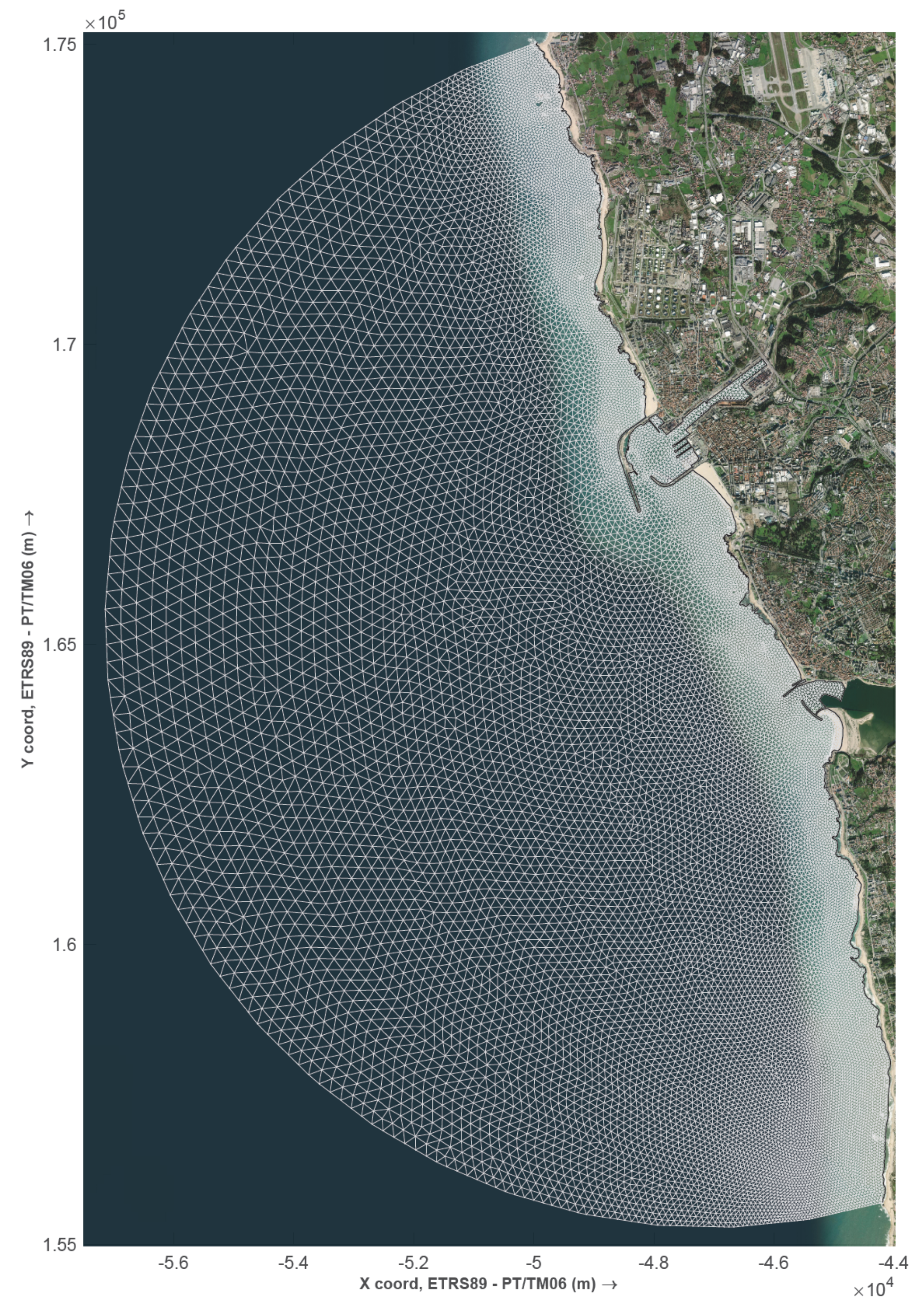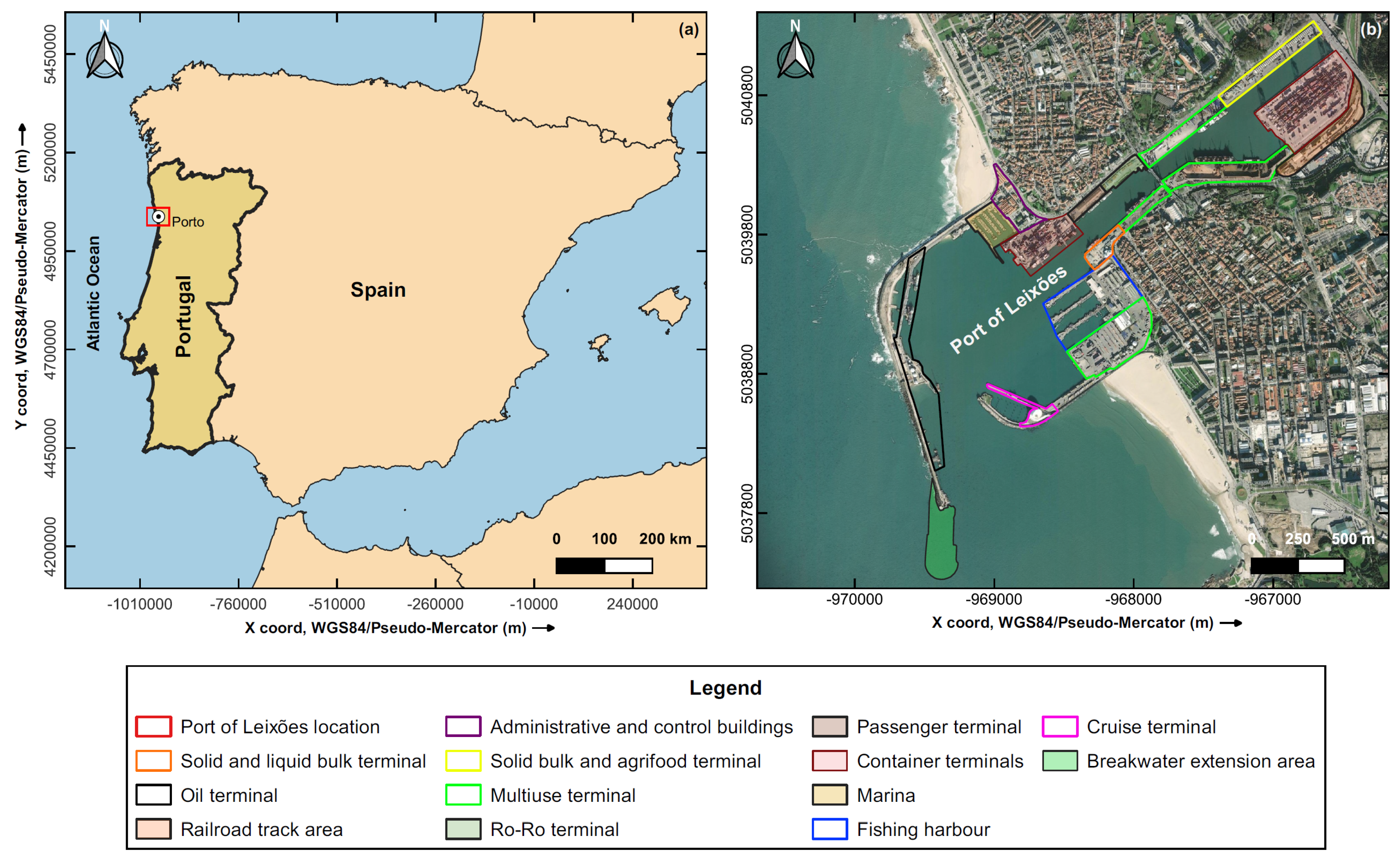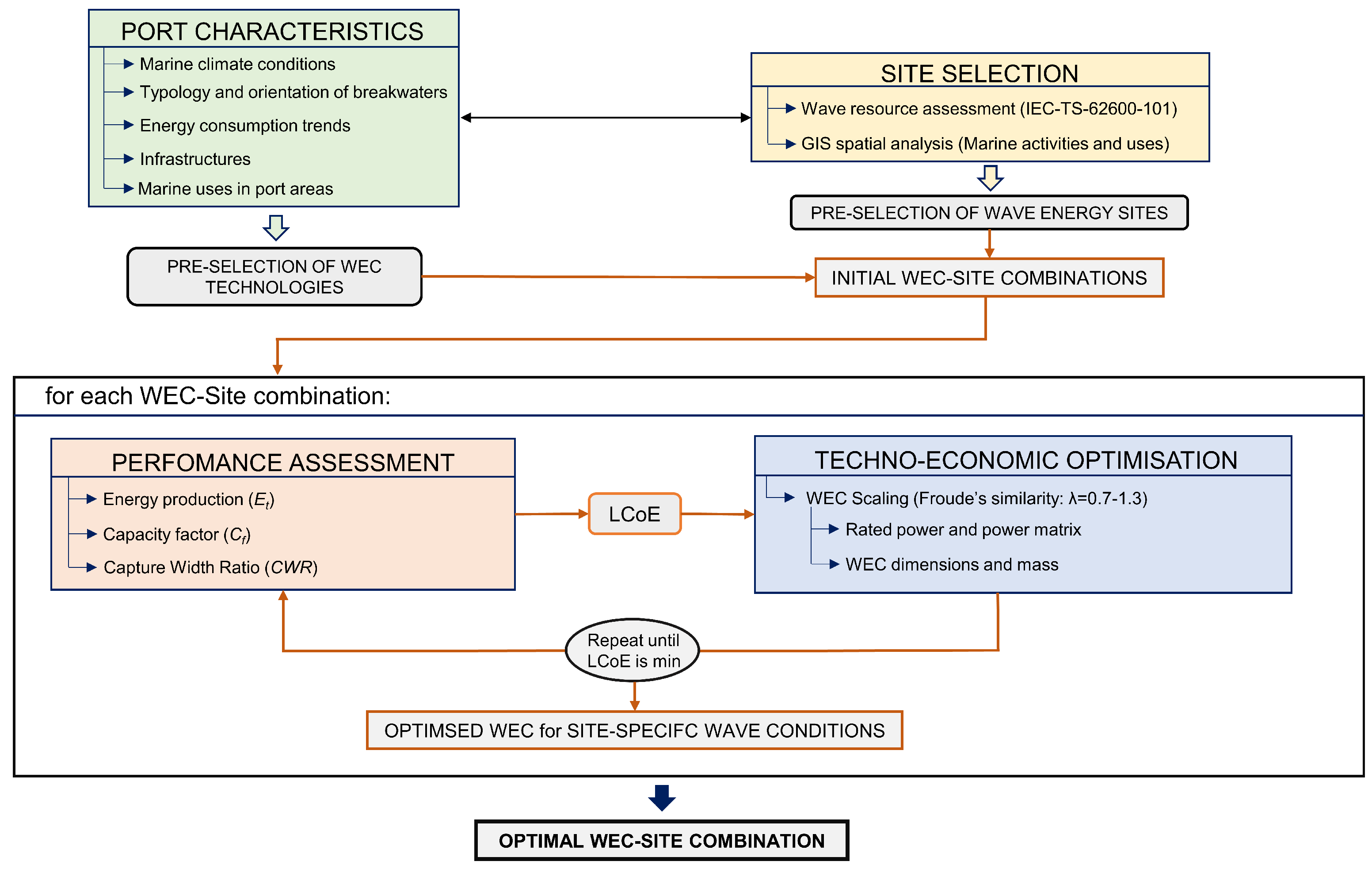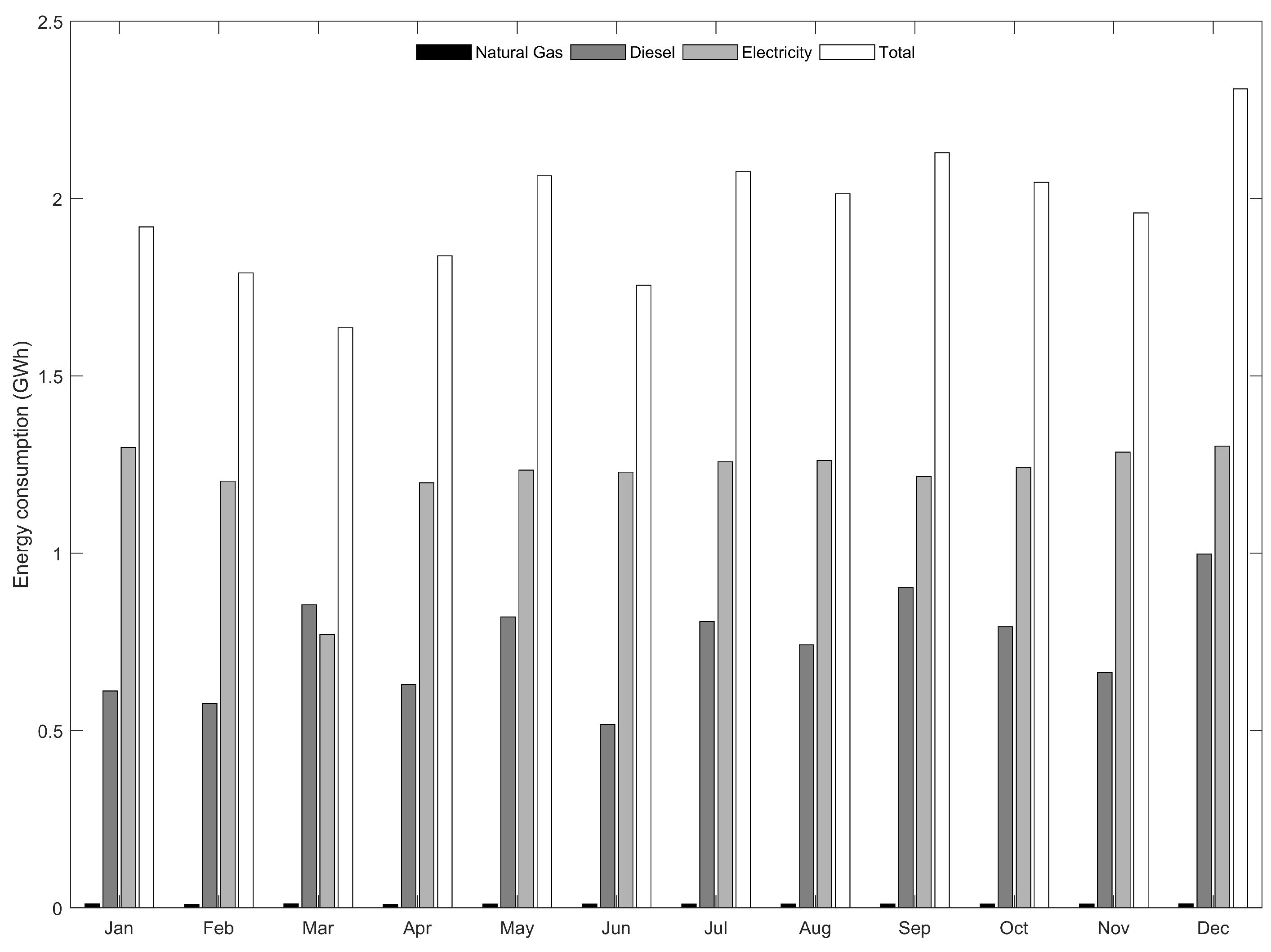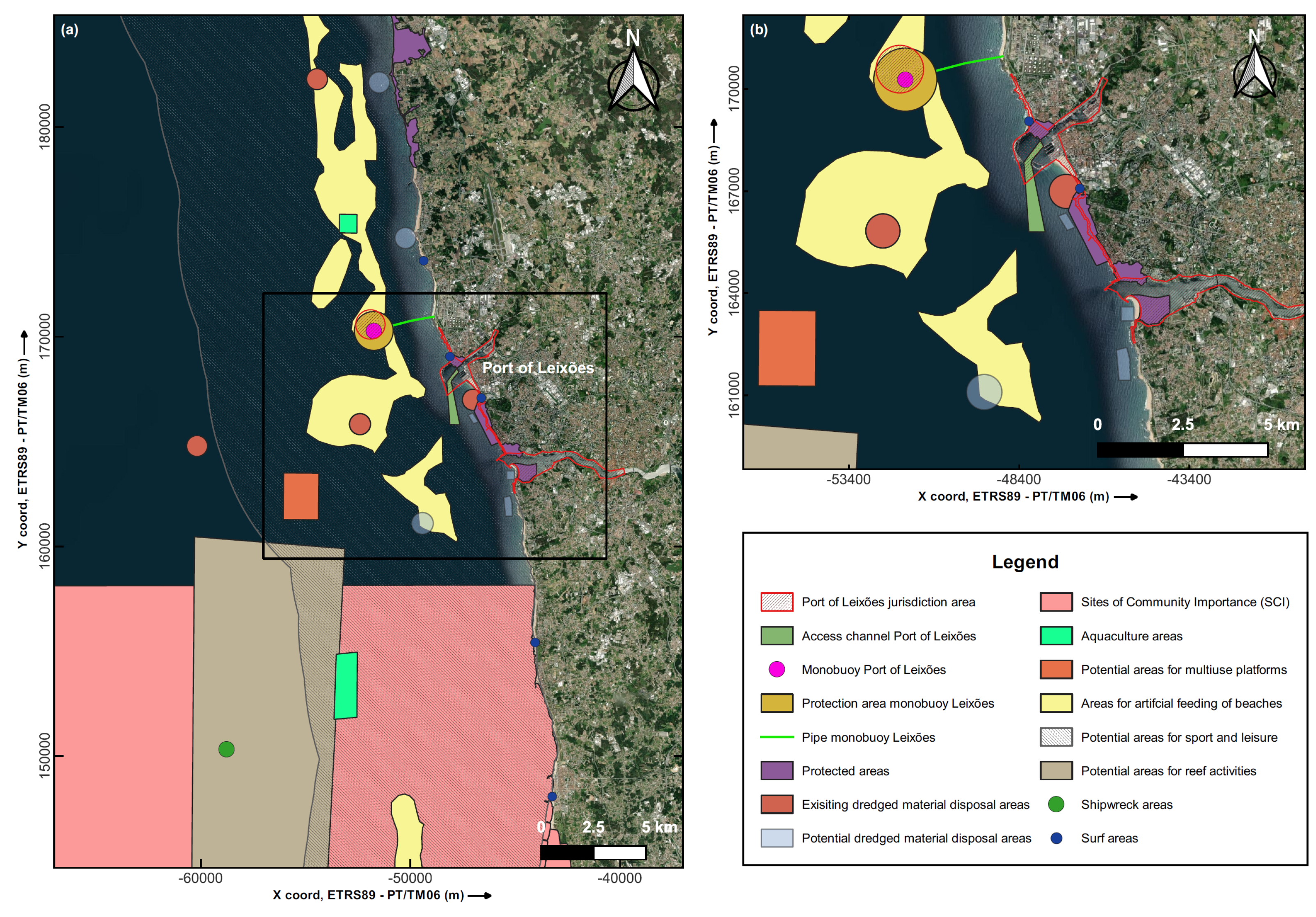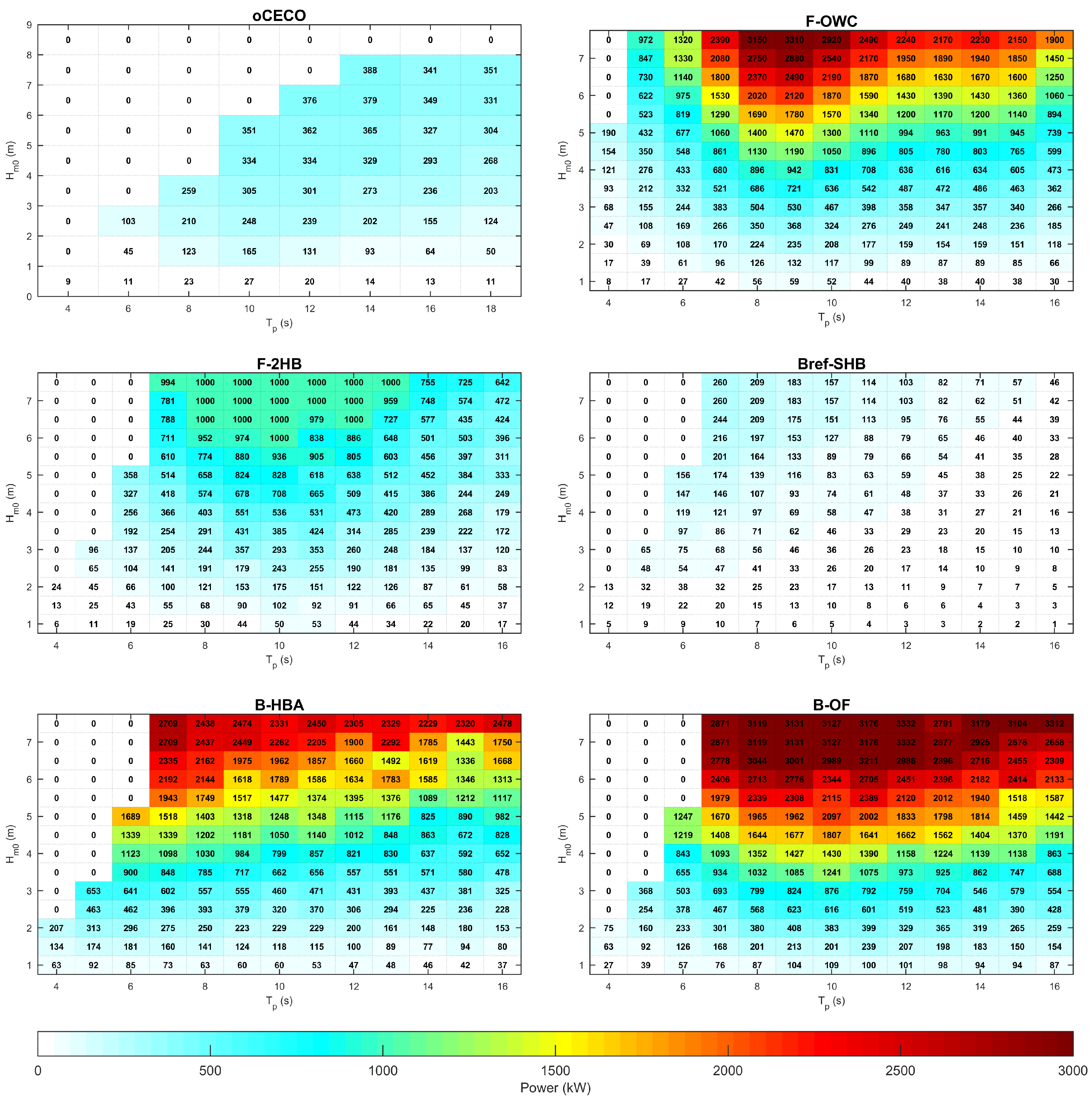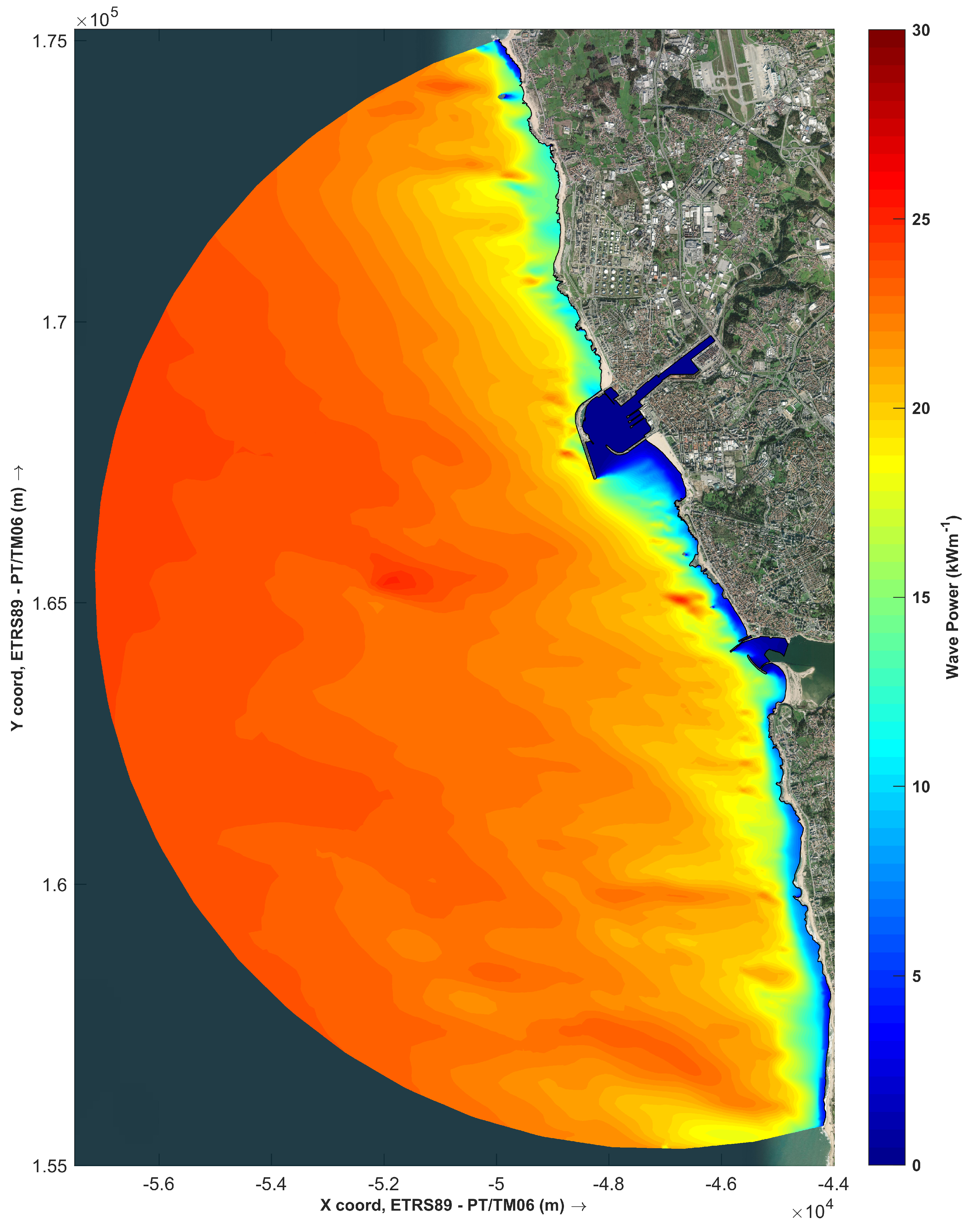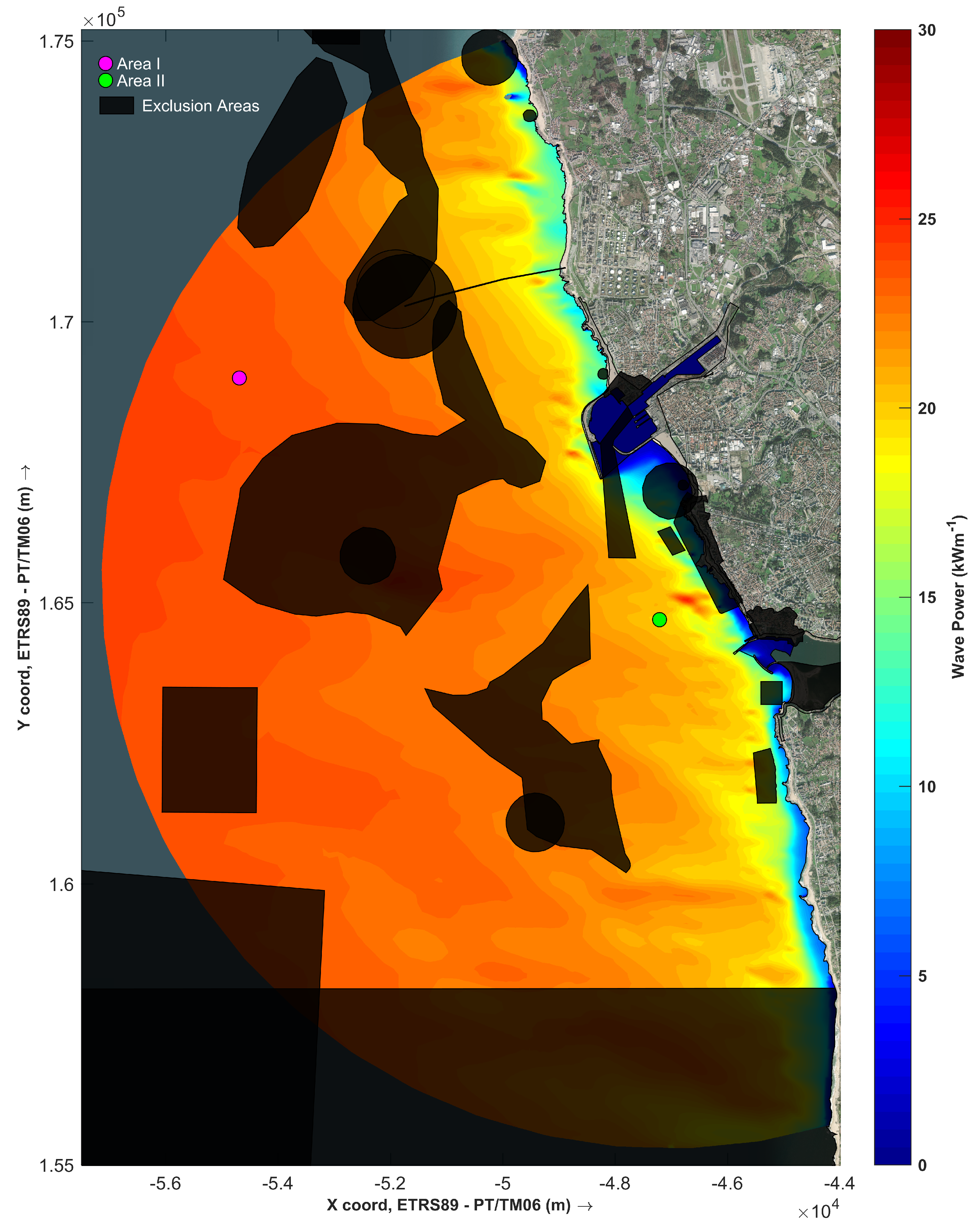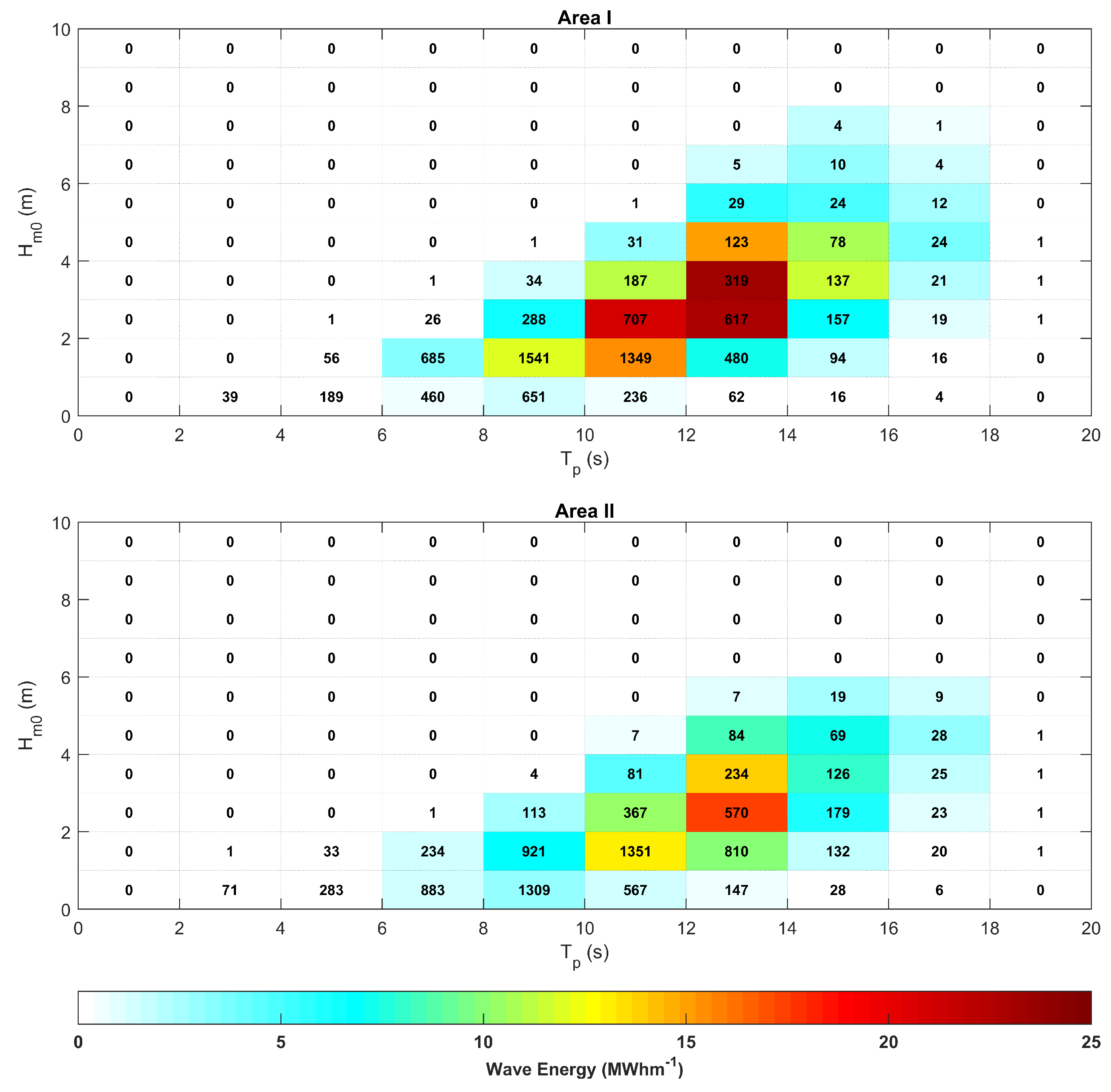1. Introduction
Over the last decade, growing concerns regarding environmental pollution, climate change, and long-term sustainability of the fossil fuel-based energy model have prompted different climate and energy policies (e.g.,
Paris Agreement [
1],
2030 Agenda for Sustainable Development [
2] and
EU’s Green Deal [
3]), whose main goals are to foment a fair transition towards a sustainable and carbon-neutral economy.
As a consequence of these policies, seaports are subject to increasing pressure to reduce their environmental footprint and transition towards a low-carbon energy model while increasing their competitiveness [
4]. Seaports are essential for global trade and economic growth since more than 80% of the world’s goods are transported by cargo vessels [
5]. In addition to cargo handling, seaports may also house a large number of activities among which, passenger transportation, fishing, aquaculture and shipbuilding, stand out. As a result, seaports present high-energy demands, which as of to date are mainly fulfilled by means of fossil-fuel energy sources [
6]. All these factors have turned seaports into significant sources of pollution, mainly in terms of noise, air/water contaminants [
7] and greenhouse gas (GHG) emissions [
8,
9].
Therefore, port authorities are developing ambitious plans to reduce carbon emissions and environmental pollution (e.g.,
World Ports Sustainability Program [
10]). In this sense, relevant ports such as Helsinki (Finland) [
11], Busan (Korea) [
12] and Houston (USA) [
13] have already presented their action plans to achieve carbon neutrality in the 2035−2050 horizon. For this purpose, efficient energy use and electrification of port equipment and activities, including onshore power supply of vessels, become essential [
6,
14]. However, port electrification together with the expected growth of maritime transport will result in a significant increase in the energy requirements of ports [
6,
15], which must be fulfilled by renewable and/or low-carbon energy sources to achieve the above-mentioned sustainability and emission targets.
On these grounds, considering the convergence of marine resources, infrastructures and facilities available at seaports, Marine Renewable Energy (MRE) appears as a promising energy solution [
16]. Among the different types of MRE sources, wave energy, which presents a large and globally diverse resource of roughly 2 TW [
17], has attracted the greatest deal of interest from the port managing authorities [
18]. Despite its large energy potential, wave energy has yet to reach commercial viability [
19]. This fact is closely related to the low conversion efficiencies of most of Wave Energy Converter (WEC) technologies [
20]. In addition, WECs commonly operate under very harsh marine conditions, jeopardising their structural integrity and increasing the difficulty in terms of logistics, deployment, operation and maintenance tasks [
21]. As a result, wave energy presents values of Levelised Costs of Energy (LCoE) that can be up to ten times higher than other traditional renewable sources such as onshore wind and solar PV [
22].
Nonetheless, for the specific case of seaports, the integration of certain types of WECs (e.g., Oscillating Water Columns (OWCs), Overtopping Devices (OTDs) and some Wave Activated Devices (WADs) [
23]) within seaport structures (e.g., breakwaters, piers and jetties) could help those WEC concepts to increase their cost-competitiveness and, consequently, progress more rapidly towards commercialisation [
18]. This approach presents several advantages. First of all, capital and construction expenditure could be shared between the breakwater and WEC [
24]. Secondly, the breakwater could serve as a foundation and shelter for the WEC, improving as a result its reliability and operating life span [
18]. Thirdly, the complexity and costs in terms of accessibility and maintenance are significantly lower than in the case of offshore wave farms [
24]. Similarly, the difficulty and costs of the WEC-grid connection are highly reduced [
25]. However, WEC-breakwater integration is not without downsides. On the one hand, not all breakwaters are suitable for WEC integration, which depends mainly on their location, orientation and typology [
26]. On the other hand, the nearshore wave transformation processes could reduce significantly the available wave energy resource, in comparison with offshore locations [
27]. Furthermore, the functionality of breakwaters, sheltering port areas from the action of the waves, cannot be compromised by the presence of WECs. Full-scale examples of WEC-breakwater integration are the OWCs of ports of Mutriku (Spain) [
28] and Civitavecchia (Italy) [
29], the overtopping device OBREC in the port of Naples (Italy) [
30] and the Eco Wave Power hinged arm point absorber in Gibraltar [
31]. In addition, extensive research has dealt with WEC-breakwater integration in different ports worldwide, addressing in detail relevant issues such as hydrodynamic and hydraulic performance enhancement of OWCs [
32,
33] and OTDs [
34,
35], respectively; PTO optimisation [
36,
37,
38], wave loading distribution and structural integrity [
39,
40,
41], economic and life-cycle environmental impact assessment [
42,
43] and hybridisation of OWC and OTD concepts [
26,
44].
Alternatively, WEC concepts such as attenuators, point absorbers and oscillating wave surge devices, which are not compatible for breakwater integration, could also increase their cost-competitiveness if they were to be deployed in the surrounding marine areas of seaports, to fulfil part of their energy demands. This approach also presents important advantages in comparison with traditional offshore wave energy farms. Among them, the vicinity between the generation and consumption points stands out [
6]. Therefore, lower energy losses and costs of installation, operation and maintenance are expected, due to the reduced length of electric export cables and the simpler requirements in terms of mooring systems and farm accessibility [
45]. Additionally, the presence of nearshore wave farms in the vicinity of seaports could help to mitigate damaging effects on coastal structures [
46] and hazards such as erosion [
47] and flooding [
48]. Another possible positive outcome, which lies beyond the scope of this work and still requires extensive research, relates to the potential impacts of wave farm operation on harbour oscillations (induced by infragravity waves) that can create significant problems to ships moored inside the harbour [
49,
50,
51] and cargo operations [
52,
53]. On the other hand, the main disadvantage of this approach are the potential disruptions with the large amount of maritime uses (navigation, fishing, aquaculture and recreational activities) that are concentrated in the vicinity of seaports, which could limit the sea-space availability for the installation of WECs [
54]. Furthermore, nearshore processes such as wave breaking and seabed dynamics may jeopardise WEC’s operating lifespan [
55]. Finally, it is worth mentioning that this approach could be also suitable for naturally sheltered ports, whose defence structures are not subject to intense wave action.
In this context, it becomes apparent that selecting the most appropriate WEC technology (e.g., OWC vs. OTD) and location of installation (breakwater-integrated vs. nearshore) to supply the energy demands of a particular port, depends on multiple factors, which include: (i) main port characteristics, considering its location, typology and orientation of coastal defence structures, energy consumption patterns and maritime activities in its jurisdiction and surrounding areas; (ii) available wave energy resource in the port and its vicinity areas [
56]; (iii) WEC typology and performance in terms of energy production, capacity factor and capture width ratio [
57]; and finally, (iv) WEC associated energy costs [
42]. Previous research dealing with WEC integration in ports has mainly focused on selecting and optimising WEC technologies according to specific breakwater characteristics [
24,
58] and assessing the resulting annual energy production [
59,
60]. However, an integrated decision-making approach, which takes into account all the aforementioned factors, must be considered when planning the optimum WEC-site combination within seaports areas.
Against the foregoing backdrop, the objective of this paper is to propose an integrated approach to assess the feasibility of exploiting the wave potential to fulfil the energy demands of ports. To this end, a methodology that takes into account the key characteristics of ports (i.e., location, breakwater typology and available wave resource) and WECs (site−specific performance and techno-economic optimisation) is developed to find the optimum WEC−site combination within seaport areas. To illustrate this methodology, the Port of Leixões is used as a case study (
Section 3). Located on the Northern coast of Portugal facing the North Atlantic (
Figure 1), the Port of Leixões is subject to one of the most energetic wave regimes in continental Europe [
56] and, therefore, appears as a compelling case study to exploit the wave energy resource to fulfil its energy needs.
The remainder of this paper is structured as follows.
Section 2 presents the methodology developed to find the best WEC-site combination for seaport areas.
Section 3 and
Section 4 describe in detail the main characteristics of the Port of Leixões and the case-study WECs considered for this work.
Section 5 and
Section 6 show the results obtained for the present case study and discuss the main aspects of the proposed methodology, respectively. Finally, conclusions are drawn in
Section 7.
4. Case-Study WECs
As mentioned in
Section 2.1, the exploitation of the wave potential to supply the energy needs of ports can be achieved using either breakwater-integrated or offshore WECs. Owing to its privileged location and layout (
Figure 1), both possibilities are suitable for the Port of Leixões. However, for the present work, the use of breakwater-integrated WECs was discarded, owing to the lack of information to accurately estimate the different costs (manufacturing, installation and decommissioning) and LCoE of these types of devices. Therefore, only offshore WEC concepts that have reached a relevant level of technology readiness (TRL ≥ 4) were considered [
71], namely, F-OWC, F-2HB, Bref-SHB, B-HBA, B-OF and oCECO. The main characteristics of those devices are summarised in
Table 2, while their corresponding power matrices are shown in
Figure 5.
F-OWC, as its name indicates, is a floating OWC [
85], which is inspired by the OE-Buoy device [
86]. It consists of a partially submerged structure with an opening aligned with the incoming wave direction connected to a single air chamber. As the water column oscillates, the air is forced to flow through an air turbine, which drives an electric generator.
F-2HB is a floating two-body heaving converter [
85], which is based on the WaveBob device [
87]. Its operating principle consists of a heaving point absorber with a hydraulic PTO that is driven by the relative motion of a torus sliding along a vertical float.
Bref-SHB is a bottom-referenced submerged heave-buoy [
85], which takes inspiration from the CETO device [
88]. It is formed by a submerged axi-symmetric buoy, which is forced to heave as a result of the pressure difference caused by wave motions. The heaving motions are captured by a hydraulic PTO, which drives an electric generator located inside the buoy.
B-OF is a bottom oscillating flap device [
85], which is derived from the Oyster device [
89]. It consists of a pitching flap fixed to the seabed, whose oscillations are converted into hydraulic energy, which is then used to drive an electric generator.
B-HBA is a bottom-heaving buoy array [
85], which is based on the Wavestar device [
90]. B-HBA is formed by several semi-spherical floaters connected to a jack-up structure by means of hinged arms. The motions of the floaters are captured by a hydraulic PTO, which drives an electric generator housed in the jack-up structure.
Finally, oCECO is a novel WEC composed of two floating modules joined by a frame, which present their motions restrained to an inclined direction to capture the vertical and horizontal force components of the waves [
91]. The longitudinal motions of the floating modules are transformed by a rack pinion system to drive a rotatory electric generator, which is housed in the floating supporting structure. It is important to point out that oCECO was developed and optimised for the wave conditions of the area of study (Northern coast of Portugal) [
92,
93]. Consequently, for the present work, oCECO was also used as a benchmark to verify the validity of the techno-economic optimisation model proposed in
Section 2.4.
6. Discussion
This section presents a discussion on the main aspects of the methodology proposed to find an optimal WEC-site combination to supply the energy needs of seaports. First of all, the results obtained in
Section 5.1 highlight that the selection of the areas to exploit the wave energy resource in the vicinity and/or port areas should be studied from a holistic perspective, considering not only the available wave energy resource but the main port characteristics, including energy consumption patterns, typology and orientation of coastal defence structures, as well as the socio-economic constrains imposed by the different maritime uses and biodiversity protected areas present in the surroundings of the port. For the case of Port of Leixões, this fact becomes apparent, with a significant amount of sea space discarded for WEC deployment due to the presence of maritime priority areas (marine navigation, disposal of dredged material and activities such as aquaculture and surf) and biodiversity areas (SCIs). As a result, the available sea surface will determine the size and capacity of the wave farm. For the present case study, due to the space limitations of Area II and the considered separation between WECs (5 times the characteristic capture width), the capacity of the farm was set to supply 50% of the annual energy demands of Port of Leixões (approx. 12 GWh). It is noteworthy to point out that despite not being considered for the present study, the proposed methodology is flexible enough to include a wave farm layout optimisation. In consequence, the size and capacity of the wave farm could be adapted even better to the port characteristics.
On the other hand, the results obtained in
Section 5.2 confirm the need of conducting a techno-economic optimisation of WECs based on the characteristics of the local wave conditions, since most WEC technologies are usually designed for specific applications and/or wave climates. In consequence, most of the case-study WECs had to be upscaled or downscaled (according to Froude’s similarity criterion,
Section 2.4) to be better suited to the wave characteristics nearby the Port of Leixões and, therefore, reduce their associated values of LCoE (from 5 to 15% as indicated in
Table 5). The only exception was the case of oCECO, for which negligible differences were found between the optimised and reference device. The latter confirms the validity of the techno-economic optimisation model proposed, since oCECO was developed and optimised for the wave conditions present in the area of study. However, it is worth noting that the LCoE model proposed in the present work is based on a deep literature review of cost estimations of the different stages of a wave energy project (manufacturing, installation, operation, maintenance and decommissioning). In addition, the cost model proposed does not take into account external factors such as spikes in the price of raw materials or inflation rates. Therefore, the proposed LCoE model should be considered as a first approximation and must be revisited when new information coming from the wave energy industry becomes available. Consequently, a conservative approach was taken for the estimation of the different costs. For example, the OPEX was estimated as 5% of the CAPEX, which corresponds to the maximum limit proposed in the literature [
45]. As a result, the model may overestimate the LCoE, especially for the nearshore WECs (B-HBA and B-OF in Area II), where the operation and maintenance costs are expected to be lower. Nonetheless, the methodology proposed is flexible enough to adjust the cost estimation according to the characteristics of the considered WEC-site combination. Finally, another aspect that may have an influence on the results obtained for the LCoE is that the wave farm layout was not optimised, which could also contribute to the overestimations of the LCoE.
7. Conclusions
In recent years, regulatory and social pressure have forced port authorities to reduce their environmental footprint and transition towards a low-carbon and more sustainable energy model. For this purpose, the inclusion of renewable sources in the energy mix of ports becomes essential. In this context, due to the availability and proximity of the resource, wave energy appears as a promising option. Therefore, exploiting the wave energy resource to supply the energy demands of ports requires an appropriate selection of WEC technologies and installation locations. However, this selection is not straightforward as depends on multiple factors, which include, among others, port exposure to wave action, typology and orientation of port sheltering structures, potential interactions with other maritime uses and associated energy costs. On these grounds, the objective of this paper is to propose an integrated methodology to select the most appropriate WEC-site combination to supply the energy demands of ports. To illustrate this methodology, the Port of Leixões, located on the Northern coast of Portugal, was used as a case study.
For the present case study, the methodology proposed has proven to be robust and coherent, being capable of identifying the optimal WEC-site combination to fulfil the energy needs of the port. Regarding the identification of wave energy sites, it was found that in addition to an accurate estimation of the wave resource, a detailed spatial characterisation of the different maritime uses in the port area is essential to avoid potential disruptions between them. For this purpose, the use of marine spatial planning instruments is highly recommended. Another key aspect of the methodology is the techno-economic optimisation proposed to adapt the WECs to the local wave conditions of ports. This stage of the methodology has proven to be highly effective, with most of the case study WECs presenting noticeable reductions (ranging from 5 to 15%) in their associated LCoE values. However, the cost estimations proposed for the LCoE model must be considered as a first approximation and should be revisited when more accurate cost information is shared by the wave energy industry. Finally, it is important to note that the methodology proposed can be applied elsewhere, using different case-study WECs.
In summary, the results obtained confirm that the methodology proposed performs well, identifying the most suitable locations for wave farm installation and optimising the devices to minimise their associated LCoE, according to the site-specific wave conditions. Nonetheless, additional aspects relevant to WEC-site selection, such as wave farm layout optimisation and seabed geology, are not considered in this work and will be addressed in detail in future research.
